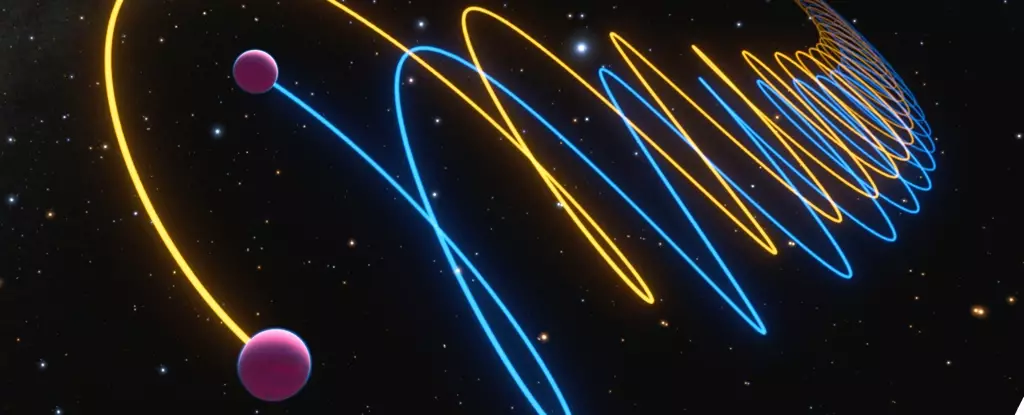In the realm of astrophysics, notable discoveries often challenge existing paradigms, pushing the boundaries of our understanding of celestial objects and their behaviors. One such breakthrough has occurred with the revelation that Gliese 229 B, a brown dwarf orbiting the red dwarf star Gliese 229, is not an isolated entity but rather a binary system comprised of two closely orbiting brown dwarfs. This finding, led by a team at Caltech’s Institute and published in the prestigious journal Nature, has profound implications for the classification and formation of cool stars and giant planets.
The mystery surrounding Gliese 229 B began in 1995, when it was first detected as a solitary brown dwarf about 19 light-years from Earth. Initially classified as an intriguing object due to its unexpected dimness relative to its mass—estimated to be around 70 times that of Jupiter—Gliese 229 B became a focal point of inquiry for astronomers striving to decipher its unique characteristics. For decades, observations suggested that it was extraordinarily faint for an object of its mass, thereby igniting speculation about its true nature.
To resolve this long-standing enigma, researchers employed advanced technologies, particularly the GRAVITY interferometer located at the European Southern Observatory’s Very Large Telescope in Chile. This cutting-edge instrument enabled the team to spatially differentiate the two components of Gliese 229 B, which were previously indistinguishable due to their close proximity. Additionally, they utilized the CRyogenic high-resolution InfraRed Echelle Spectrograph (CRIRES+) to analyze the distinct spectral signatures emitted by each brown dwarf.
The insights gleaned from these observations confirmed that Gliese 229 B is actually a pair of celestial bodies, designated Gliese 229 Ba and Gliese 229 Bb, with masses of approximately 38 and 34 times that of Jupiter, respectively. This groundbreaking discovery not only clarified the mystery surrounding Gliese 229 B’s luminosity but also opened up new avenues of research into the nature of brown dwarfs and their formation mechanisms.
The classification of Gliese 229 B as a binary system carries significant implications for the broader field of astrophysics. Brown dwarfs, often described as “failed stars,” occupy a niche between gas giants and true stars, residing on the boundary of stellar and planetary classification. The revelation that Gliese 229 B consists of two closely orbiting low-mass objects enriches our understanding of this category and prompts new questions about the processes involved in their formation.
One notable theory posits that binaries like Gliese 229 Ba and Bb could form from the fragmentation of a star’s protoplanetary disk, with gravitational interactions allowing these diminutive bodies to become bound together. This theory enhances our comprehension of other celestial phenomena, including closely orbiting exoplanet binaries, which share similar dynamics. Consequently, the continued study of such brown dwarf systems may illuminate the complexities of star and planet formation in diverse astrophysical environments.
The discovery of Gliese 229 B’s binary nature stands on the shoulders of past research and collaborative efforts extending back to its initial observation in 1995. The blend of expertise from teams across various institutions—including Caltech, NASA, the European Space Agency, and others—demonstrates the power of collective scientific inquiry. Researchers Rebecca Oppenheimer, Jerry W. Xuan, and Dimitri Mawet, among others, played pivotal roles in this landmark study, highlighting the contributions of both seasoned astrophysicists and emerging talent.
The work surrounding Gliese 229 B underscores the necessity of interdisciplinary approaches and innovative technologies in tackling complex astronomical mysteries. As the field evolves, so too does our capacity to study previously unnoticed celestial phenomena.
With this recent discovery, the horizon appears bright for future investigations into binary brown dwarf systems. Researchers intend to utilize both existing technologies and next-generation instruments, such as the Keck Planet Imager and Characterizer (KPIC) and the High-resolution Infrared Spectrograph for Exoplanet Characterization (HISPEC), to uncover additional brown dwarf binaries in the cosmos.
The declassification of Gliese 229 B as a solitary brown dwarf represents a pivotal moment in astrophysics, enriching our understanding of these fascinating cosmic entities and the mechanisms that bind them together. This discovery not only exemplifies the captivating nature of astrophysical research but also inspires the quest for knowledge that continues to propel our exploration of the universe.


Leave a Reply